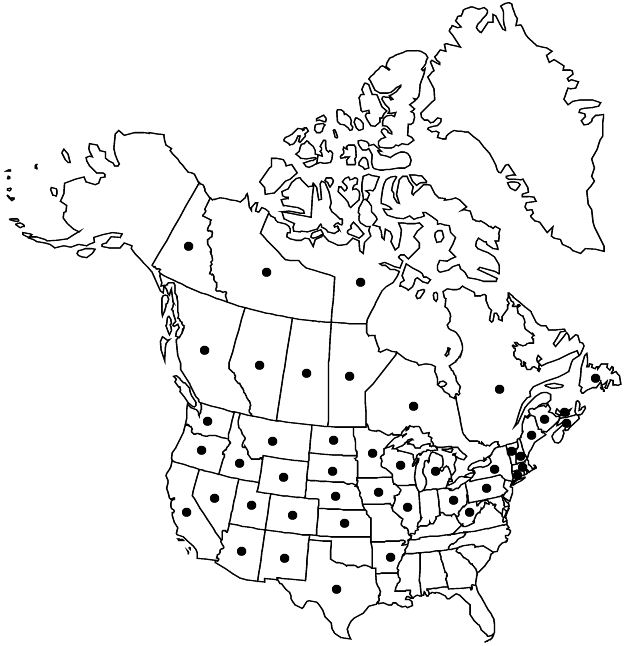Difference between revisions of "Viola nephrophylla"
Pittonia 3: 144. 1896.
FNA>Volume Importer |
FNA>Volume Importer |
(No difference)
| |
Revision as of 22:43, 16 December 2019
Plants perennial, acaulescent, not stoloniferous, 5–15 cm; rhizome slender, becoming thick and fleshy with age. Leaves basal, 4–7, ascending to erect; stipules lanceolate, margins entire or fimbriate, apex acute; petiole 2–25 cm, usually glabrous; blade usually grayish green or purplish green abaxially, unlobed, ovate, reniform, or broadly reniform to orbiculate, 1–7 × 1–7 cm, somewhat fleshy, base broadly cordate or reniform to ± truncate, margins crenate to serrate, ciliate or eciliate, apex acute to obtuse or rounded, surfaces usually glabrous, rarely sparsely pubescent. Peduncles 3–25 cm, usually glabrous. Flowers: sepals ovate, margins usually eciliate, auricles 1–2 mm; petals deep bluish violet on both surfaces, lower 3 white basally and darker violet-veined, lateral 2 bearded, upper 2 sometimes sparsely bearded, lowest densely bearded or beardless, 10–28 mm, spur same color as petals, gibbous, 2–3 mm; style head beardless; cleistogamous flowers on erect to ascending peduncles. Capsules ovoid, 5–10 mm, glabrous. Seeds beige to brown or dark brown, 1.5–2.5 mm. 2n = 54.
Phenology: Flowering Jan–Sep.
Habitat: Wet habitats in saturated soil in prairies, pastures, bogs, fens, sedge meadows, rocky shores of lakes and streams, limestone outcrops, gravelly calcareous stream beds
Elevation: 100–3000 m
Distribution

Alta., B.C., Man., N.B., Nfld. and Labr. (Nfld.), N.W.T., N.S., Nunavut, Ont., P.E.I., Que., Sask., Yukon, Ariz., Ark., Calif., Colo., Conn., Idaho, Ill., Iowa, Kans., Maine, Mass., Mich., Minn., Mont., Nebr., Nev., N.H., N.Mex., N.Y., N.Dak., Ohio, Oreg., Pa., S.Dak., Tex., Utah, Vt., Wash., W.Va., Wis., Wyo.
Discussion
Viola nephrophylla has the widest distribution in North America of any of the acaulescent blue violets.
There is some question whether the species we now know as Viola nephrophylla fits with the protologue and type specimen(s). McKinney examined the type designated by Greene; it appears that what most botanists have called V. nephrophylla may be an undescribed taxon. N. L. Gil-Ad (1997) believed Greene’s type contained plants that were genetically impure based on seed coat micromorphology and suggested the specimens might be a mixture of both orthospecies and introgressants.
Viola mccabeiana was described by M. S. Baker in 1940 from collections made in British Columbia. Later, Baker (1949b) discussed the reasons why the name V. mccabeiana needed to be abandoned. C. L. Hitchcock et al. (1955–1969, vol. 3) treated V. mccabeiana as synonymous with V. nephrophylla var. cognata. While Viola mccabeiana is recognized in Canada (L. Brouillet et al., http://data.canadensys.net/vascan/), we believe it is best included within V. nephrophylla.
Viola nephrophylla reportedly hybridizes with V. cucullata (= V. ×insessa House), V. sororia var. sororia (= V. ×napae House), and V. affinis (= V. ×subaffinis House).
Selected References
None.